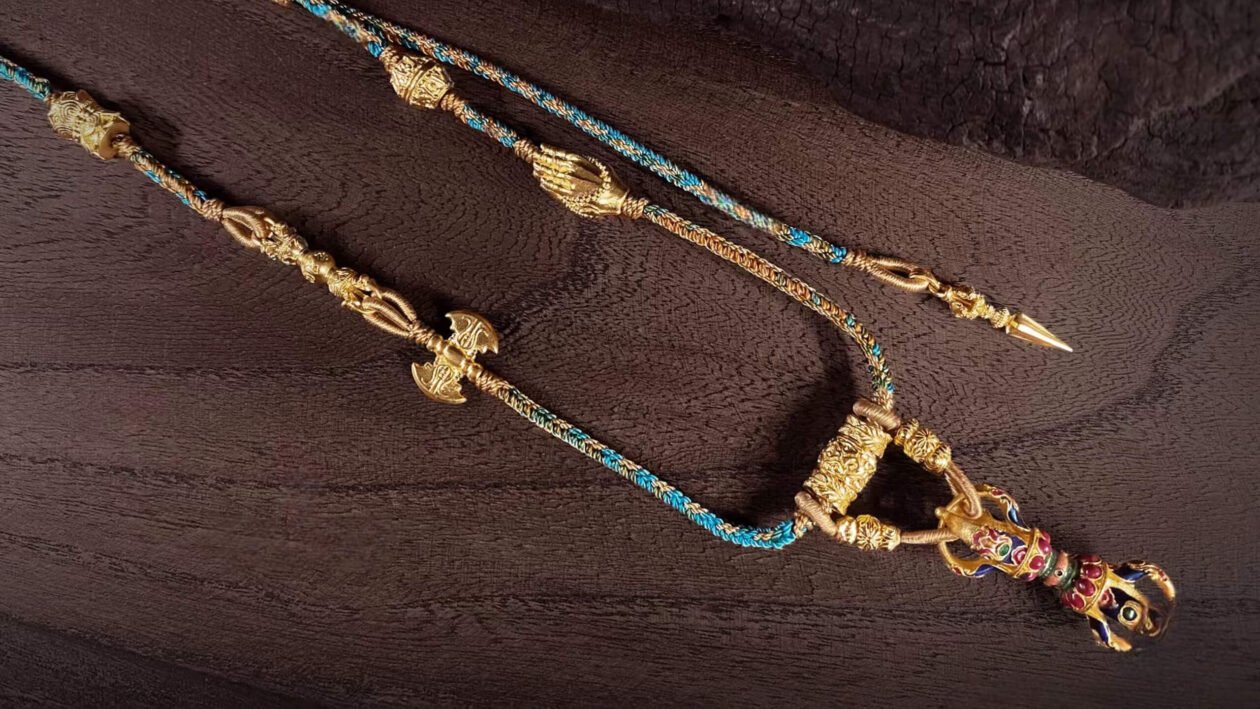
Vajra: A symbol of a Dharma instrument in Buddhist culture and a guide to its use
- Post Date: 04 11 月, 2024
I. The origin and history of the vajra
The origin of the vajra, the history of the vajra, and the Buddhist Dharma instrument
The vajra, also known as the vajra bell pestle, is a Dharma instrument originating from Tantric Buddhism and Hinduism, and has a long history. The “vajra” in its name means indestructible, symbolizing wisdom and strength, while the “pestle” represents the power of the instrument to exorcise demons and break through obstacles.
The vajra first appeared in ancient India and was widely used by Tantric believers to exorcise evil and purify the mind. After Buddhism spread to China, Tibet, Nepal and other regions, the vajra gradually became a common Dharma instrument for practitioners, symbolizing the power of wisdom to break through ignorance and enlightenment to overcome troubles.
II. The shape and design features of the vajra
The shape of the vajra, the design of the vajra, the type of the vajra
The design and material of the vajra are diverse, and metal materials such as copper, silver, and gold are often used to demonstrate its strength and tenacity. The vajra usually has a moderate handle in the middle, with lotus, flames or unique patterns on both ends, symbolizing the perfection and fearlessness of the Dharma.
According to its different forms, the vajra is divided into single pestle, double pestle, triple pestle, and five pestles:
Single pestle: represents Buddhist wisdom and symbolizes the awakening power to break through confusion.
Double pestle: symbolizes the unity of duality, implying the combination of yang and yin, wisdom and compassion.
Three pestles: corresponds to the “three treasures” of Buddha, Dharma, and Sangha, and is intended to convey the solid power of faith.
Five pestles: represents the power of the five Buddhas, protects the Dharma and removes obstacles, and at the same time breaks the five poisons (greed, anger, ignorance, arrogance, and doubt).
Each type of vajra design contains fine craftsmanship and religious symbols. These features make the vajra not only a Dharma instrument, but also a work of art that symbolizes Buddha nature and power.
Ⅲ. The cultural connotation and symbolic meaning of the vajra
The symbolic meaning of the vajra, the culture of the vajra, and the symbol of Buddhist Dharma instruments
In the Buddhist Tantric Buddhism, the vajra symbolizes wisdom and the power to break through obstacles, and is intended to help practitioners remove mental obstacles, transcend troubles, and gain the power of tranquility and enlightenment. In the meditation practice of holding the vajra, practitioners regard troubles as objects that need to be “destroyed” to achieve inner purification.
Vajra not only symbolizes the protection of Dharma instruments, but also conveys the spirit of awakening and wisdom. Especially in Tibetan Buddhism, vajra is often used in pairs with vajra bells (bells): vajra represents “male principle” and wisdom, vajra bell symbolizes “female principle” and compassion, the combination of the two symbolizes the perfect combination of wisdom and compassion, is an important symbol in Tantric practice, and helps practitioners realize emptiness and great compassion.
Ⅳ. How to use vajra and its role in practice
How to use vajra, practice vajra, vajra holding method
Vajra is widely used in Buddhist rituals and personal practice. Practitioners can hold vajra for Dharma protection meditation and use it as a self-defense tool; in daily life, vajra can also be used as a talisman, placed at home or carried with you to increase a sense of stability and protection. The following are several common ways of use:
Pestle meditation: Practitioners hold vajra for meditation to destroy troubles and concentrate their minds.
Placement at home: Vajra is often placed on the family altar, symbolizing the protection of the home and praying for peace.
Carry with you: Small vajra ornaments or pendants can be worn with you, symbolizing the power of protection.
With vajra bell: In Tibetan Buddhism, vajra is used together with vajra bell, symbolizing the perfect balance of wisdom and compassion.
As a symbolic instrument of Tantric Buddhism, vajra is used in various ways. It is not only needed for religious rituals, but also helps people gain spiritual peace in daily life.
Ⅴ. How to choose and maintain vajra
Vajra selection, vajra maintenance, vajra cleaning
When choosing a vajra, it is recommended to consider the material and size. Copper, silver and gold-plated vajra have their own characteristics. Copper vajra is more durable, while silver and gold-plated vajra symbolize higher craftsmanship and magic power.
When maintaining the vajra, it should be avoided from contact with water and acidic substances to prevent oxidation or rust. In addition, the vajra can be wiped regularly with a clean cloth to keep the surface smooth.
For vajra that has been used for a long time, it is recommended to place it in the sun for a while after cleaning, or to worship it in the Buddhist hall for a period of time to enhance its spiritual power.
In daily maintenance, proper cleaning and storage can keep the vajra for a long time and give full play to its protective function.
As an important instrument of Tantric Buddhism, the vajra symbolizes power, wisdom and protection. It has profound cultural connotations and is also an important tool for practitioners in their daily practice.
By understanding the origin, design features, cultural significance and usage of the vajra, users can more deeply appreciate the spiritual power brought by Buddhist instruments. I hope this article can help readers further understand the vajra and gain the protection and enlightenment it brings.
-
 White crystal-Buddhist beads Vajra$800.00
White crystal-Buddhist beads Vajra$800.00 -
 Golden Vajra$20,000.00
Golden Vajra$20,000.00









